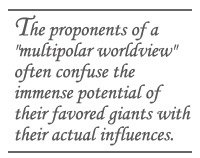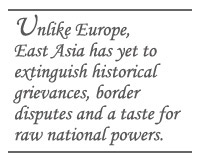Is the Sun Setting on US Dominance? – Part II
Is the Sun Setting on US Dominance? – Part II

CAMBRIDGE: It has become fashionable to talk about the arrival of a multipolar world, in which the US faces increasing competition from rising powers like Europe, China and India, or resurgent powers like Russia and Japan. Proponents of such a "multipolar worldview" often claim to hold a "realist" view of international relations. They believe the US should retreat from its ideological crusade and instead engage in a contest for influence with other global "poles", à la "the Great Game," on "unclaimed playgrounds such as Africa or Latin America.
However, realism is only as good as its assessment of reality. The view of multiple powers competing for global influence is a misleading assessment of international relations today and for the near future.
The proponents of such a "multipolar worldview" often confuse the immense potential of their favored giants with their actual influences. They often overlook the immense internal difficulties these rising giants must overcome to realize their potential. Most importantly, they do not take full account of the strategic interactions between these giants during their simultaneous rise and the strategic opportunities that such interactions present for the US.

Among the rising powers, the European Union boasts by far the largest economy, with a strong currency and a comparatively large and prosperous population. However, after a long drive of expansion, Europe faces a serious cohesion problem. It still suffers from a weak security framework that's dependent on NATO and a legalistic rather than executive center in Brussels. Although the EU does chase strategic interests in its proximities such as the central Asia and North Africa, it does so, not for any overreaching vision to compete globally, but mostly for parochial economic reasons. Europe is not yet competing in any "Great Game," for the simple reason that Europe is not yet unified.
Recent rejections of the EU constitution show that serious resistance remains towards further integration.
After recent stabilization of its economy, a resurgent Russia is often mentioned as a future global power. However, Russia faces severe long-term internal challenges. Its population is declining and aging, its vast Siberia territories hollowing out after the end of Soviet subsidies. Extractive industries such as hydrocarbon, mining and timber account for 80 percent of Russia's exports and 30 percent of its government revenue, whereas its manufacturing industries are mostly outdated and uncompetitive. Russia therefore will have serious issues with its self-image as a major world power, finding it hard to forge an assessment of its global role commensurate with its long-term demographic and economic realities.

Japan has a similar problem of updating its self-image as the most "advanced" nation in Asia for more than 100 years. Today Japan faces the harsh reality that, after its neighbors catch up, Japan will again find itself a geographically small, resource-poor island nation dependent on trade, living uneasily among large, populous continental neighbors. It has a largely pacifist, prosperous population in a neighborhood still rife with nationalism. Unlike Europe, East Asia has yet to extinguish historical grievances, border disputes and a taste for raw national powers. As Japan itself proved, economic rises, once initiated, can be rapid indeed, so its current economic strength does not guarantee its future influence. Furthermore, barring a rapid re-militarization, Japan's growth in national strengths is bound to be slower than that of its still maturing neighbors, therefore its relative strategic position in East Asia will only grow weaker. Either re-militarization or an erosion of its self-perceived leadership in the region is likely to require a profound reassessment of Japan's postwar consensus of national purposes.
India sees itself as an up-and-coming power, proud to be a democracy yet simultaneously aspiring to more traditional "hard" powers. As a diverse and still poor country, it faces immense internal challenges. Its manufacturing base and infrastructure need major overhaul. Beyond these, India is limited by its geographical constraint in the South Asia and the thorn in its side that’s Pakistan.
Sandwiched between Pakistan, Burma and the Himalayas, India’s ambition beyond the subcontinent could not blossom until its geographical perimeter is secured.

China borders three of the ambitious giants – India, Russia and Japan. China's neighborhood is far tougher than that of either Europe or the US. Like India, China is a large, poor country rife with internal tensions. Unlike Europe or America, its current form of government does not enjoy wide ideological appeal. Compared with Russia’s or even Japan’s, its military is still modernizing. It has recently become fashionable in America and Europe to describe Chinese "expansions" in Africa and South America. But the evidence is mostly economic deals over raw materials. This is not expansionism, but mercantilism.
China is indeed playing an active geopolitical game in its immediate environment: Southeast Asia, Central Asia and Korea Peninsula. But this only serves to show that China is still mired in local complexities. By contrast, US foreign policy often takes Latin America for granted, overshadowed by global hotspots like the Middle East. Even more fundamentally, China has yet to reconcile its geopolitical destiny with the unfulfilled ambitions of its three giant neighbors.
The last point applies equally for other rising powers. Russia already butts heads with Europe over the latter’s eastward expansion, and may look nervously at its Siberian possessions in the face of the overwhelming population across Chinese borders. Japan could have followed the 19th-century British role as the island balancer to prevent any one power from dominating the continent, but China is much larger than either Napoleonic France or Kaiser Germany. India sits between two neighbors who have close ties with China, Pakistan and Burma, and unresolved borders with China in the north. All these countries lie on a continuous Eurasia landmass, with its many sets of complex geopolitics, and confront competing aspirations of giant neighbors. For these giants, local concerns with neighboring powers will carry more urgency than global ambitions.

This leaves the US, secure in its isolation, the only country with a true global horizon. Throughout the 19th century, Britain played the dual role of a global power and an island balancer: It aimed both to ensure command of sea and to prevent the dominance of the continent by a single power. A realist US foreign policy today would play a similar game on a larger scale, aiming to hobble rising powers in their own regional niches in the Eurasia continent. With this goal, local alliances like that between the US and Japan will be more crucial than global contests for influences. This is not a "Great Game" played by a number of true global powers in a "multipolar world."
More fundamentally for a realist, however, is a need to define strategic interests in this new century. Are they raw materials, territories or sea lanes, allies or ideological influence? What kind of allies, military or commercial? Until these questions are answered, we do not yet know what the shape the future realpolitik will take, for the simple reason that we do not know what constitutes "core interests" for the US and the regional giants. But one thing is clear: As long as the rising powers compete with one another regionally, the US will hold the key as the dominant balancer even in its perceived decline.
Jiang Qian is a postdoctoral researcher with Eric Heller’s Group and the Condensed Matter Theory Group at Harvard University.